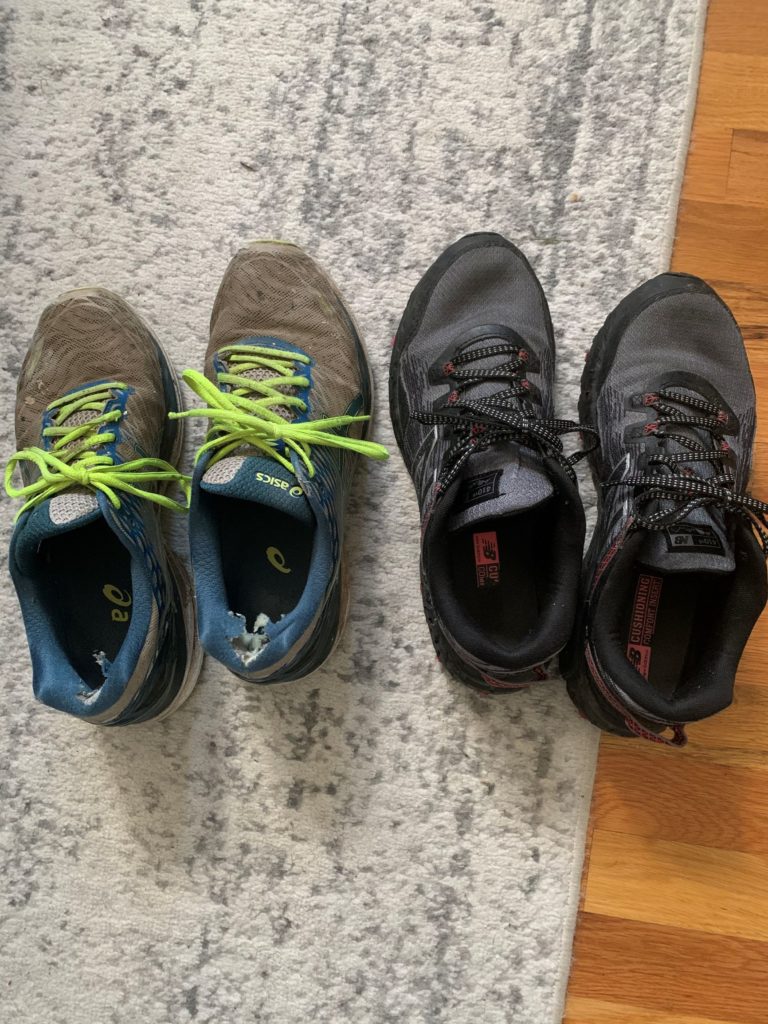There are some common truths in niche circles around gear, specifically footwear. As I have mentioned previously, my upbringing was frugal and I still have a hard time letting go of some of those tendencies. I have held on to shoes that as long as they are not falling apart, they still have life. As I age, I am starting to change my opinion on that definition of life left in shoes.
Several years ago, I trained for a half marathon. It was supposed to be a goal to be more healthy at 40 than 30. As life got in the way, and I mostly mean work, I didn’t make a half marathon at forty, but I did at forty-one. I ran a number of different races in preparation and I met a lot of people, most of which were much more serious than me about running.
A commonly held belief is that running shoes have about 150-200 miles in them before they are worn out. Training for a half marathon at 5-10 miles a day, that is about a pair of shoes every month or two. What I noticed is that my hip and or knee would start bothering me about that mileage and the pain would go away when I switched to new shoes. So, I guess that I concur with that consensus.

A lot of those shoes would not appear severely worn out other that what I would see is tread wear at the heal. I felt bad throwing out a mostly intact pair of shoes, but I couldn’t keep running in them. The pain was not worth it. So, they would get rotated into the casual wear pile. For that type of use, the pain would not appear unless I was literally on my feet all day, not something I would plan on but would occasionally happen.
I didn’t run seriously long enough to develop much experience with all the different brands. I have always had an affinity with Asics that goes all the way back to my cross country days. Trying and using multiple models from that manufacturer, some were really great and others I hated. I tried other brands along the way as well; I have never liked Nike, New Balance seem to take a long time to break in but seem to last longer, Fila – No. There are still others that I would like to know about but never got the opportunity.
I say all that because I believe that shoe comfort and performance is personal. I suspect that mass manufacturing has enough variability in the tolerances causing users different experiences in use. There are some specific stores focused on running apparel that take pictures of your feet and pressure points to provide optimal performance like Road Runner Sports. This of course comes at heavy price. Average shoe costs are running at $150-200. They do offer great returns and sell used items kind of like REI and Patagonia do for there circles.
Running is one example, but there is also a colloquialism in hunting that nothing ruins a hunt like bad feet. Boots also come in many different styles and features. There are many different designs for different applications and terrain. High lace is supposed to help for ankle stability. Mountaineering boots tend to be super stiff. There is insulation at different levels.
What I have learned about boots is that I would prefer a non-insulated boot if I am going to walk a lot because you feet tend to sweat with that kind of activity. I haven’t been in cold enough to benefit with the amount of insulation that I have in my current boots. Many have soles that are glued onto the shoe which makes them non-serviceable in the future, if the glue fails. I also like a waterproof boot because I don’t need to be as careful where I step.
This whole diatribe is about the fact that I need new shoes. As much time as I am spending on my feet delivering packages, I am noticing pain with my old shoes. I have one pair of shoes that I bought last spring to start training for a multiple day hike that are still usable. They are running shoes, so my feet are getting wet walking in wet grass and stepping in puddles. So, I am looking for a pair of waterproof, low hikers. I want to keep it light, durable and comfortable. I haven’t decided on a brand or model yet.
I wanted to go through all of this to encourage you to consider the condition of your footwear and provide some of the insights I have learned with my sporting activity. You shouldn’t need pain and being on your feet a lot, consider this some of the most important gear you can invest in. One more thing, I feel like you get what you pay for for the most part. I am not convinced a $50 versus a $75 pair makes much of a difference but $40 versus $180 could.
Recent Comments